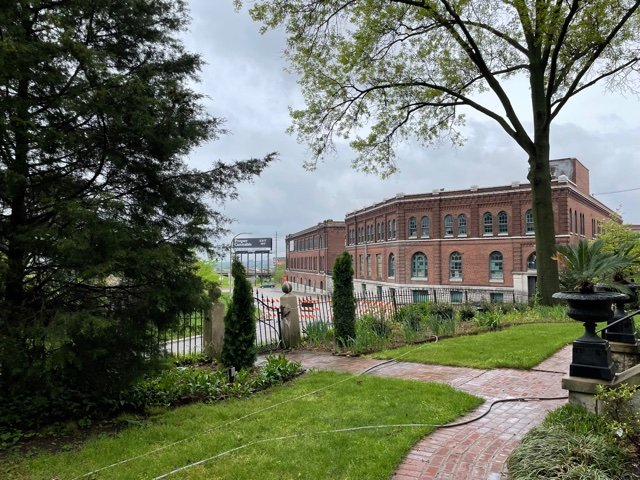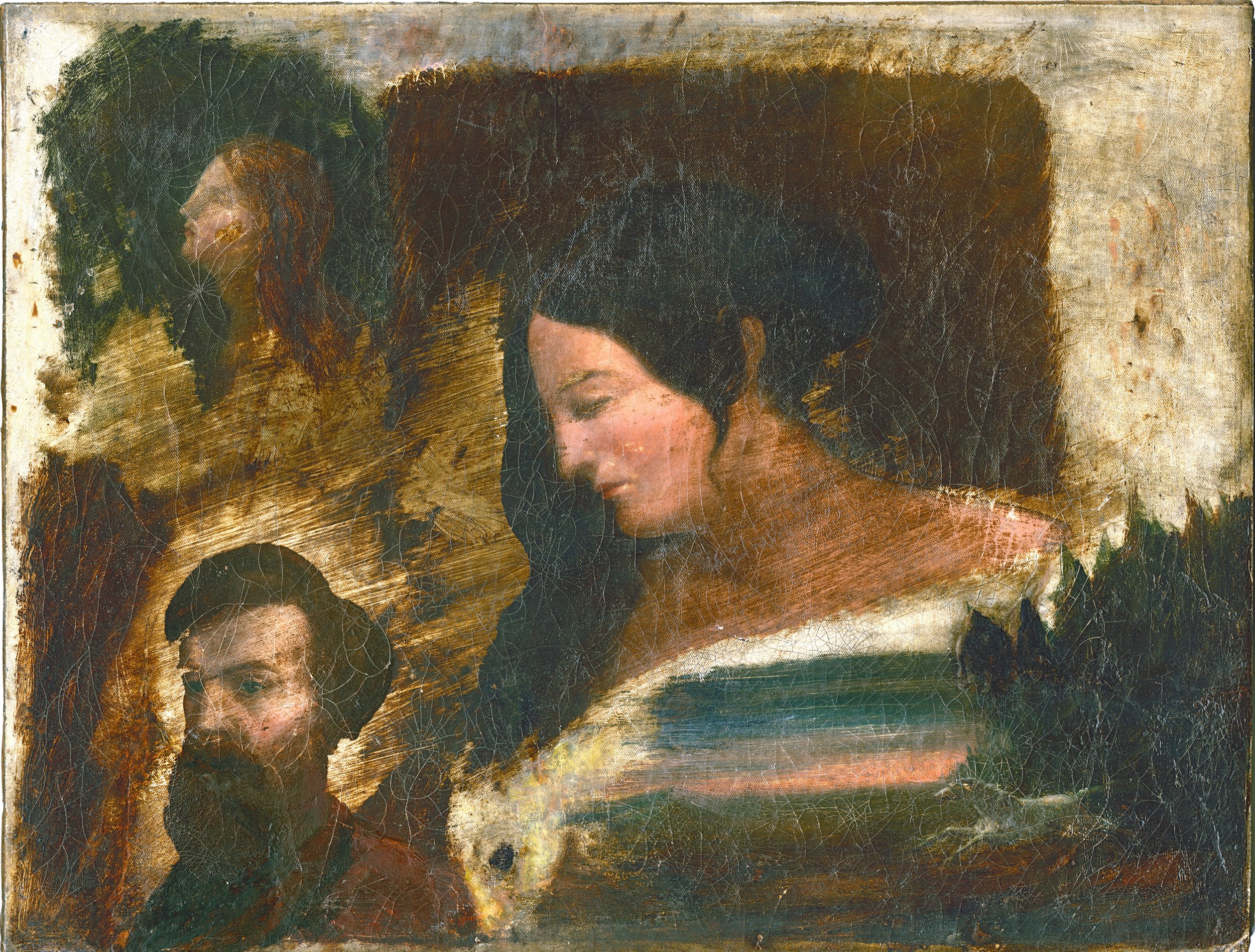Please sign up below for our quarterly newsletters…
Henri Chatillon's Hawken Rifle
Workmen undertaking extensive restoration of the Mansion in the 1960s made an amazing discovery. While repairing the attic in what had been the original Chatillon part of the structure, they came upon a mysterious canvas painting wrapped around a muzzle-loading rifle.
Henri Chatillon’s Hawken rifle was a gift from Francis Parkman, author of The Oregon Trail
The painting was identified later as an allegorical memorial to Bear Robe, Henri Chatillon’s first wife, an Oglala Sioux, who died in 1846 while Henri was on an expedition. It shows a portrait of Bear Robe, a figure of a horse, which in her tradition would carry the spirit of the deceased to the next world, and a likeness of Chatillon and their daughter. The painting is on display today in the Mansion.
The rifle was identified at the time as a Hawken rifle, the “rifle that tamed the West.” which was made in St. Louis by Jacob and Samuel Hawken, sons of a Pennsylvania rifle-smith. Their rifles were famous for their accuracy, long range and comparatively light weight. They were designed for the needs of Rocky Mountain fur trappers, traders and explorers. They became synonymous with the term “mountain rifle” and were individually made, not mass-produced.
Davy Crockett, Daniel Boone, Kit Carson, Robert Campbell, Jim Bridger and Francis Parkman, Jr. are just some of the famous men who owned one.
Parkman, a 22 year old recent graduate of Harvard with a degree in Law, came to St. Louis to prepare for a trip through the American West to hunt and to observe Native Americans. While he was here, he ordered a Hawken rifle and he selected Henri Chatillon to be his guide.
Chatillon was employed as a trapper, guide and hunter for the Laclede-Chouteau fur trading operation. It is said that he could stand in the stirrups of a racing horse and shoot down a buffalo.
Upon his return from his expedition, Parkman presented his rifle to Chatillon, his “true-hearted friend”, as an expression of friendship and as a token of his appreciation for his services.
Parkman’s account of his exploration through the West was published as The Oregon Trail: Sketches of Prairie and Rocky-Mountain Life.
The Hawken House Museum in Webster Groves was built by one of Jacob’s sons, Christopher Hawken.
Bill Stanard, the Executive Director of the Foundation, has obtained a replica of a Hawken rifle and visitors to the Mansion will have an opportunity to hold this copy of what must have been Chatillon’s prized possession.
Sadly, the present location of the rifle found in the attic is unknown.
--Wardwell Buckner
In the Tradition: Bastille Day in St. Louis and at DeMenil
Bastille Day celebrations in St. Louis, Missouri, in the 19th century were a time of great excitement and festivity. The French Revolution was a source of great inspiration for many Americans, and Bastille Day was seen as a celebration of liberty and democracy.
The first Bastille Day celebration in St. Louis was held in 1803, just a few years after the Louisiana Purchase. The event was organized by a group of French immigrants and was held at the city's first Catholic church, the Cathedral of St. Louis. The celebration included a parade, speeches, and a fireworks display.
In the years that followed, Bastille Day celebrations in St. Louis became increasingly elaborate. By the mid-19th century, the city was home to a large and vibrant French community, and Bastille Day was one of the biggest holidays of the year. The celebrations typically included a parade, a picnic, and a fireworks display.
Alexander DeMenil greatly expanded family leadership in the Bastille Day event, playing a prominent role over a period of four decades. In 1896, he organized Sociéte du 14 Juillet, a group from the local French community dedicated to preparing for the annual celebration often held at Lemp’s Park (now Cherokee Park) located a block north of the DeMenil House.
Celebrations in St. Louis reached their peak in the late 19th century. In 1889, the city celebrated the centennial of the French Revolution with a massive celebration that included a parade, a concert, and a fireworks display. The event drew over 100,000 people and was widely considered to be one of the most successful Bastille Day celebrations in American history.
There are many different ways to celebrate Bastille Day, from attending a parade or festival to simply enjoying a French meal. It's a great way to learn more about French culture and to show your support for our enduring relationship with modern-day France.
On July 16th at 1 pm, join us at the Mansion for our yearly celebration with liquid refreshment, a special reading of the Rights of Man, a demonstration of French Courtly dance, a chance to fire a flintlock rifle, and the meeting of Marie Antoinette and Mme Gillotine. For tickets, visit www. demenil.org/event-tickets
With a Little Help from our Friends
With the aid of generous multi-year funding from the Ladue Garden Club, a major renewal has taken place reshaping the gardens along the street fence lines which surround the Mansion to the west, south and east.
On the west fence line, the two beds flanking the DeMenil Place entrance have become rose gardens following a Creole inspired design by Mary Hayward consisting of coral, peach, and white drift roses, a type of rose that is bred to be a groundcover.
Rose beds under construction
They are compact, low-growing, repeat-blooming, and have a long bloom season. Mary chose them because they are particularly disease resistant and relatively low maintenance. In the center of each rosebed stands a boxwood tri-sphere topiary.
Seen from the back balcony
They fill the space previously occupied by two overgrown crabapple trees which blocked the view of the Mansion from the street. The two beds are outlined by a boxwood hedge composed of 90 boxwoods.
On the east side of the Mansion, the completely overgrown bed at the intersection of Cherokee Street and the I-55 onramp has been cleared following a design by Tim Rohan. Holly bushes have been planted along the fence and will be kept low to preserve the view of the Mansion from the highway, the best remaining vista of the Mansion’s Ionic columned portico since the Interstate was built.
The eastern fence line along the I-55 ramp presents problems. While the best view of the Mansion is from the on-ramp (closed during highway repairs and perhaps soon to be abandoned), the worst view of traffic on the ramp and the highway from the Mansion’s grounds is just a little further along the ramp.
Tim Rohan’s design solves the problem of opening a view on one end and blocking it on the other end. Further north along the highway, additional trees were planted earlier this spring to fill gaps between existing trees in order to provide a dense hedge blocking the view of the highway from the Mansion’s grounds.
Bear Robe Painting Image Enhanced
There are a few reasons why old oil paintings, like our portrait of Bear Robe, Henri Chatillon's Oglala Sioux wife, look so dark.
The pigments used in old oil paintings made from natural materials, such as ochre or indigo were not as bright as the pigments used today. Also, The varnishes that were used to protect old oil paintings yellowed over time.
Bear Robe canvas after enhancing for clarity
In recent years, there has been a growing interest in restoring our Bear Robe portrait, but the expense of a full restoration of the c. 1848 oil is prohibitive.
We contacted a number of artists in the St. Louis area, and they pointed us towards a high tech solution called a giclée. A giclée is a high-quality, archival inkjet print made from a digital file. The term giclée is derived from the French word gicleur, which means "to spray". Giclees are often used to reproduce fine art or photography.
A master of the giclee, Jim Robbins at Velham Printing used a digital scanner to digitize the Bear Robe painting, allowing him to work on the image in a digital format, an easier and more versatile method than working with a physical painting and non-destructive to the original canvas.
Using a photo editing program to adjust the colors, contrast, and brightness of the image, he edited the original painting's image, printed the painting on an actual canvas, and stretched it on a frame the same size as the original. As you can see from the enhanced images, Bear Robe's portrait takes on new life as the record of two American originals, Henri Chatillon and Bear Robe.
Bear Robe’s white horse for mobility in her afterlife
DeMenil House Foundation
Board of Directors
Mary Hayward, President
Mary Stiritz, Vice President
Joe Carpenter, Treasurer
Tom Grady, Secretary
Ted Atwood, Director
Ward Buckner, Director
Jane Chouteau, Director
Bill Hart, Director
Shashi Palamand, Director
Tim Rohan, Director
Bill Stanard, Executive Director
Published August 2023







